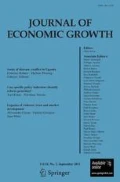Abstract
Thisarticle decomposes the well-documented relationship between financialdevelopment and growth. We examine whether financial developmentaffects growth solely through its contribution to growth in ``primitives'' or factor accumulation rates or whether it alsohas a positive impact on total factor productivity growth. Ourresults suggest that indicators of financial development arecorrelated with both total factor productivity growth and investment.However, the indicators that are correlated with total factorproductivity growth differ from those that encourage investment.In addition, many of the results are sensitive to the inclusionof country fixed effects, which may indicate that the financialdevelopment indicators are proxying for broader country characteristics.
Similar content being viewed by others
References
Arellano, Manuel, and Stephen Bond. 1991). “Some Tests of Specification of Panel Data: Monte Carlo Evidence and an Application to Employment Equations.” Review of Economic Studies 58, 277-298.
Banerjee, A., and A. Newman. (1991). “Risk Bearing and the Theory of Income Distribution.” Review of Economic Studies 58, 211-265.
Barro, Robert J., and Jong Wha Lee. (1993). “International Comparisons of Educational Attainment.” Journal of Monetary Economics 32, 363-394.
Benabou, Roland. (1996). “Equity and Efficiency in Human Capital Investment: The Local Connection.” Review of Economic Studies 63, 237-264.
Bencivenga, Valerie R., and Bruce D. Smith. (1991). “Financial Intermediation and Endogenous Growth.” Review of Economic Studies 58, 195-209.
Benhabib, Jess, and Jordi Gali. (1995). “On Growth and Indeterminacy: Some Theory and Evidence.” Carnegie Rochester Series in Public Policy 43, 163-212.
Benhabib, Jess, and Boyan Jovanovic. (1991). “Externalities and Growth Accounting.” American Economic Review 81, 82-113.
Benhabib, Jess, and Mark M. Spiegel. (1994). “The Role of Human Capital in Economic Development: Evidence from Aggregate Cross-Country Data.” Journal of Monetary Economics 34, 143-173.
Caselli, Francesco, Gerardo Esquivel, and Fernando Lefort. (1996). “Reopening the Convergence Debate: A New Look at Cross-Country Growth Empirics.” Journal of Economic Growth 1, 363-390.
Clague, Christopher, Philip Keefer, Stephen Knack, and Mancur Olson. (1999). “Contract-Intensive Money: Contract Enforcement, Property Rights, and Economic Performance.” Journal of Economic Growth 4, 185-212.
Deininger, Klaus, and Lyn Squire. (1996). “ANewData Set Measuring Income Inequality.” World Bank Economic Review 10, 565-591.
Dhareshwar, Ashol, and Vikram Nehru. (1993). “A New Database on Physical Capital Stock: Sources, Methodology and Results.” Revista de Analisis Economico 8, 37-59.
Easterly, William, Normal, Loayza, and Peter Montiel. (1997). “Has Latin America's Post-Reform Growth Been Disappointing?” Journal of International Economics 43, 287-311.
Galor, Oded, and Joseph Zeira. (1993). “Income Distribution and Macroeconomics.” Review of Economic Studies 60, 35-52.
Greenwood, Jeremy, and Boyan Jovanovic. (1990). “Financial Development, Growth, and the Distribution of Income.” Journal of Political Economy 98, 1076-1107.
Hall, Robert E., and Charles I. Jones. (1999). “Why Do Some Countries Produce So Much More Output Per Worker Than Others?” Quarterly Journal of Economics 114, 83-116.
Holtz-Eakin, Douglas, Whitney Newey, and Harvey S. Rosen. (1988). “Estimating Vector Autoregressions with Panel Data.” Econometrica 56, 1371-1395.
Islam, Nazrul. (1995). “Growth Empirics: A Panel Data Approach.” Quarterly Journal of Economics 110, 1127-1170.
Jodice, D., and D. L. Taylor. (1983). World Handbook of Social and Political Indicators. New Haven: Yale University Press.
Judson, Ruth. (1996). “Do Low Human Capital Coefficients Make Sense? A Puzzle and Some Answers.” Board of Governors of the Federal Reserve System Finance and Economics Discussion Series.
King, Robert G., and Ross Levine. (1993a). “Finance and Growth: Schumpeter Might Be Right.” Quarterly Journal of Economics 108, 717-738.
King, Robert G., and Ross Levine. (1993b). “Finance, Entrepreneurship, and Growth.” Journal of Monetary Economics 32, 513-542.
Klenow, Peter J., and Andres Rodriguez-Clare. (1997). “The Neoclassical Revival in Growth Economics: Has It Gone Too Far?” N.B.E.R. Macroeconomics Annual 1997. Cambridge, MA: MIT Press.
Knight, Malcolm, Norman Loayza, and Delano Villanueva. (1993). “Testing the Neoclassical Theory of Economics Growth: A Panel Data Approach.” International Monetary Fund Staff Papers 40, 512-541.
Krueger, Alan G., and Mikael Lindahl. (2000). “Education for Growth: Why and for Whom?” N.B.E.R.Working Paper No. 7591.
Levine, Ross. (1997). “Financial Development and Economic Growth: Views and Agenda.” Journal of Economic Literature 35, 688-726.
Levine, Ross. (1999). “Law, Finance, and Economic Growth.” Journal of Financial Intermediation 8, 8-35.
Levine, Ross, and David Renelt. (1992). “A Sensitivity Analysis of Cross-Country Growth Regressions.” American Economic Review 82, 942-964.
Levine, Ross, and Sara J. Zervos. (1993). “What HaveWe Learned About Policy and Growth from Cross-Country Regressions?” American Economic Review 83, 426-430.
Ljungqvist, Lars. (1993). “Economic Underdevelopment: The Case of a Missing Market for Human Capital.” Journal of Development Economics 40, 219-239.
Mankiw, N. Gregory. (1997). “Comment on the Neoclassical Growth Revival in Growth Economics.” N.B.E.R. Macroeconomics Annual 1997. Cambridge, MA: MIT Press.
Mankiw, N. Gregory, David Romer, and David N. Weil. (1992). “A Contribution to the Empirics of Economic Growth.” Quarterly Journal of Economics 106, 407-437.
Mincer, J. (1974). Schooling, Experience and Earnings. New York: Columbia University Press.
Nelson, Richard R., and Edmund S. Phelps. (1966). “Investment in Humans, Technological Diffusion, and Economic Growth.” American Economic Review 56, 69-75.
Newey, Whitney K., and Kenneth D. West. (1987). “Hypothesis Testing with Efficient Method of Moments Estimation.” International Economic Review 28, 777-787.
Papageorgiou, Chris. (1999). “Human Capital as a Facilitator of Innovation and Imitation in Economic Growth: Further Evidence from Cross-Country Regressions.” Louisiana State University Working Paper No. 98-16.
Romer, Paul M. (1990). “Endogenous Technological Change.” Journal of Political Economy 98, S71-S102.
Saint-Paul, Gilles, and Thierry Verdier. (1993). “Education, Democracy, and Growth.” Journal of Development Economics 42, 399-407.
Sala-i-Martin, Xavier. (1997). “I Just Ran Two Million Regressions.” American Economic Review: Papers and Proceedings 87, 178-183.
Solow, Robert M. (1956). “AContribution to the Empirics of Economic Growth.” Quarterly Journal of Economics 70, 65-94.
Topel, Robert. (1999). “Labor Markets and Economic Growth.” In Ashenfelter, Orley, and David Card (eds.), Handbook of Labor Economics (vol. 3C) Amsterdam, North Holland.
Author information
Authors and Affiliations
Rights and permissions
About this article
Cite this article
Benhabib, J., Spiegel, M.M. The Role of Financial Development in Growth and Investment. Journal of Economic Growth 5, 341–360 (2000). https://doi.org/10.1023/A:1026599402490
Issue Date:
DOI: https://doi.org/10.1023/A:1026599402490




